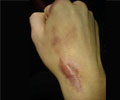Specialized skin cells that decline as you age is responsible for slow wound healing.

- Wound healing process slows down as you age.
- Keratinocytes near the injured wound fails to send immune signal and delays wound healing.
- Discovery of new proteins that reverse aging found to improve wound healing.
Elaine Fuchs, the Rebecca C.Lancefield Professor and head of the Robin Chemers Neustein Laboratory of Mammalian Cell Biology said, "Within days of an injury, skin cells migrate in and close the wound, a process that requires coordination with nearby immune cells. Our experiments have shown that, with aging, disruptions to communication between skin cells and their immune cells slow down this step."
Fuchs, Howard Hughes Medical Institute investigator said,"This discovery suggests new approaches to developing treatments that could speed healing among older people."
Wound Healing Mechanism
Specialized immune cells beneath the skin are essential to heal wounds. Scientists carry out various new experiments through which keratinocytes near the injured wound were found to direct immune cells by providing proteins called Skints. These proteins are capable of communicating with the immune cells to fill the gap.
Brice Keyes, former postdoc in Fuch’s lab, and researcher at Calico Life Sciences, says "Wound healing is one of the most complex processes to occur in the human body."
Skin cells and immune cells for wound healing process usually begins with a formation of a scab. Keratinocytes travel and fills the wound site under the scab.
The research team focused on wound healing between a 2 month old and 24 month old mice to be equivalent to 20 and 70 year old humans respectively.
The findings of the study suggested that in older mice, Keratinocytes at the wound edge failed to send the immune signals and were taking much longer time to migrate and fill the wound under the scab and as a result of which longer time is required to heal wounds.
How to Reverse Wound Healing in Older Skin
In order to enhance skint signaling in older skin, scientists discover a protein which is capable of filling the immune cells that release after injury. These proteins were applied to young and old mice skin in a petri dish.
Scientists found an increased rate of keratinocyte migration to be more prominent in the old skin and were able to conclude that the same principle would help to develop treatment options for age related slow down in wound healing.
"Our work suggests it may be possible to develop drugs to activate pathways that help aging skin cells to communicate better with their immune cell neighbors, and so boost the signals that normally decline with age.” Fuchs said.
Source-Medindia













